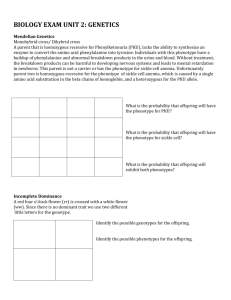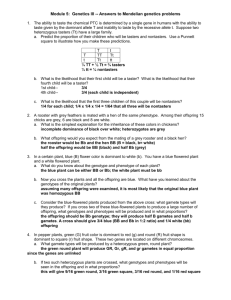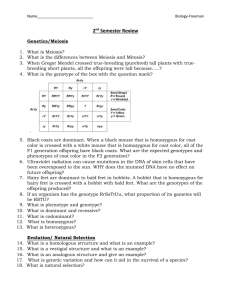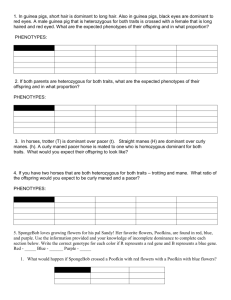CB098-011.10_Genetics Story Problems
advertisement
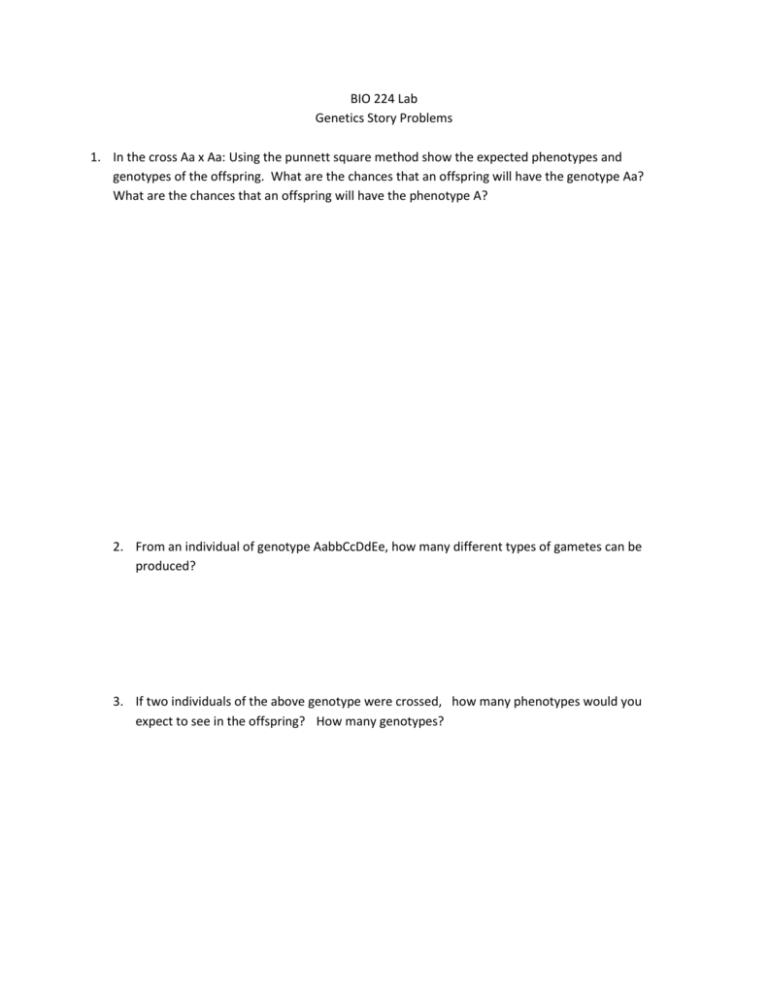
BIO 224 Lab Genetics Story Problems 1. In the cross Aa x Aa: Using the punnett square method show the expected phenotypes and genotypes of the offspring. What are the chances that an offspring will have the genotype Aa? What are the chances that an offspring will have the phenotype A? 2. From an individual of genotype AabbCcDdEe, how many different types of gametes can be produced? 3. If two individuals of the above genotype were crossed, how many phenotypes would you expect to see in the offspring? How many genotypes? 4. In many plants, the alleles for red and white flower color exhibit an intermediate dominance. If a red flowered plant is crossed with a white flowered plant, what color flower might you expect? _________________________ If two plants from such a cross were mated to produce the F2 generation, what phenotypic and genotypic ratios would you expect? 5. In platy fish, caudal blot (Cb) is dominant over wild type (+). If two fish with Cb are crossed, and their offspring all show caudal blot, what are the genotypic possibilities of their parents? If the offspring show 22 Cb and 7 wild type, what are the most likely genotypes of the parents? 6. In horses, the trotting gait (T) is dominant over the pacing gait (t), and the bay color (A) is dominant over black (a). The A gene is actually a modifier gene that acts to restrict the black pigment of an otherwise black horse (in the dominant A form) to the points of the horse (mane, nose legs etc.). A different gene, E results in a black horse in its dominant form (EE or Ee) or a chestnut horse in its recessive form (ee). A horse that is Aa ee is: ________________________ A horse that is Aa Ee is: ________________________ Farmer Tim just bought a bay trotter stallion. What are the possible genotypes of this horse (for all three genes)? This stallion is crossed with two mares. Mare 1 is a bay trotter, and produced a bay pacer colt. Mare 2 is a black trotter, and produced a black trotter colt. A second colt from this mare is a chestnut trotter. What is the genotype of Tim’s stallion? 7. In corn snakes, the wild type pigmentation is typically a saddle type pattern running the length of the snake on the dorsal and lateral sides composed of black, brown, orange, red and gray scales. Two independent biochemical pathways produce the pigments that result in these colors. On mutant (b), often seen in the pet trade, cannot produce melanin (amelansitic), and is missing any black or brown pigment. This in the homozygous state, results in a snake with only shades of red, orange and yellow. A mutation in the other pigment pathway, results in the failure to produce any red, orange or yellow pigments. Such a snake homozygous for this mutation (o) has a pattern seen as only shades of gray (anerythristic or axanthic). Both these traits are off course recessive. A snake homozygous for both these mutations cannot produce any pigment and is a complete albino (called a snow corn). If a wild type male is mated with a female snow corn, and the offspring are: 14 wild type, and 5 amelanistic, what is the most likely genotype of the male? ___________________________ If you mate a male snow corn with a homozygous wild type female, what will the offspring look like? _______________________ What will their genotypes be? If you were to take one of the offspring from above, and mate it with a snow corn, what kind of offspring would you expect, and in what ratio? 8. If a man of blood type AO marries a woman of blood type AB: What possible phenotypes could be found in their children? In what ratio would you expect to find these phenotypes? 9. Assume dark hair is dominant over light hair. If a woman who is homozygous for dark hair marries a man with light hair, what are the chances they will have light-haired children? If a woman who is heterozygous for dark hair marries a man with light hair, what are the possible genotypes of their children? What are the possible phenotypes of those children? 10. Hemophilia A is an X-linked trait in humans. If a woman who is a carrier for Hemophilia A has children with a normal man, what is the probability that a male child would be born with Hemophilia A? What is the probability that a female child will be born with Hemophilia A? If the same woman had children with a male who has Hemophilia A, what is the probability that a male child would be born with Hemophilia A? What is the probability that a female child would be born with Hemophilia A? This workforce solution was funded by a grant awarded under the President’s CommunityBased Job Training Grants as implemented by the U.S. Department of Labor’s Employment and Training Administration. The solution was created by the grantee and does not necessarily reflect the official position of the U.S. Department of Labor. The Department of Labor makes no guarantees, warranties, or assurances of any kind, express or implied, with respect to such information, including any information on linked sites and including, but not limited to, accuracy of the information or its completeness, timeliness, usefulness, adequacy, continued availability, or ownership. This solution is copyrighted by the institution that created it. Internal use by an organization and/or personal use by an individual for noncommercial purposes is permissible. All other uses require the prior authorization of the copyright owner.
